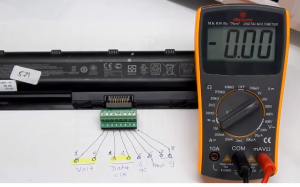The laptop battery is one of the most critical components of a laptop computer. Their lifespan is limited, and their performance declines over time. To ensure that laptop batteries function properly, they should be checked regularly.
The purpose of this article is to show how to check the voltage of a laptop battery using a multimeter. In addition, it shows how to test laptop battery with multimeter?

A multimeter is an easy and straightforward way to test the voltage of a laptop battery and assess the battery’s health. Using our step-by-step guide, you can determine whether you need to replace your laptop battery.
What is a Multimeter?
Multimeters measure the voltage, current, and resistance of electronic components. It comes with two probes for testing electrical circuits, components, and devices.
Different types of multimeters are available, such as analog and digital multimeters. Most multimeters are digital, and they have more features than analog ones.

I am using here digital multimeter and high quality battery to test its performance and life span.
Safety Precautions Before Testing Laptop Battery
It is important to take some safety precautions before testing your laptop battery.
- Turn off the laptop and disconnect it from any power source.
- Additionally, you should ensure that the multimeter probes and your hands are both dry.
- Protect yourself from accidents by wearing gloves and goggles.
Preparing for the Test
In order to test the battery of a laptop with a multimeter, you will need to gather the necessary tools, such as a multimeter, probes, and a screwdriver. Choose the correct voltage settings on the multimeter according to the manufacturer’s instructions. You should set your multimeter to the DC voltage range of 20 volts if your laptop battery is 11.1 volts.
Testing the Laptop Battery with a Multimeter
When testing a laptop battery with a multimeter, it is important to take into consideration the weight factor of the laptop. The weight of the laptop can affect the accuracy of the test results, as heavier laptops tend to have larger batteries with higher capacities.
To account for the weight factor, it is recommended to use the following formula when calculating the battery capacity:
Battery capacity = (voltage reading x current reading) / (weight of laptop x weight factor)
The weight factor can vary depending on the make and model of the laptop, and it is usually provided in the manufacturer’s specifications. By using the weight factor in the calculation, you can obtain more accurate results that take into account the weight of the laptop and its impact on the battery capacity.

Here are the steps that you should follow if you want to test your laptop by multimeter.
Charged Laptop Fully
Firstly make sure your laptop battery is fully charged. And if your charger not properly working you can use HDMI to charge your laptop.
Turn Off Laptop
After charging 100% laptop battery turn off your laptop. So you cannot get a sock or your laptop battery may go out.
Remove Battery Connector Cover with a Screwdriver
To remove the battery connector cover with a screwdriver, locate the cover on your laptop, which is typically situated near the battery. Unscrew the cover using a compatible screwdriver, taking care not to damage any components. Once the cover is removed, you can access the battery connector and proceed with testing the battery with a multimeter.
Locate Battery Connector
You must locate the battery connector on your laptop in order to test its battery.Usually, it is located on the underside of the laptop. In case you don’t find it, so you can consult your laptop’s user manual or search online for its location.
Turn on the Digital Multimeter
To turn on the digital multimeter, press the power button, which is typically located on the front or side of the device. Once turned on, the multimeter may display a default reading or show zero. Ensure that the multimeter is set to the correct measurement range and function before using it to test your laptop battery.
Identify the Connector Ports
The multimeter probes should be connected to the positive and negative terminals of the battery connector. It is important that the probes are in good contact with the terminals.
Read the Readings on the Multimeter
Once you have made the necessary connections, the multimeter display will show the measurement value. For example, if you are measuring voltage, the display will show the voltage value in volts (V). If you are measuring current, the display will show the current value in amperes (A).
It’s important to note that some multimeters have an auto-ranging function, meaning they will automatically adjust the measurement range based on the value being measured. However, some multimeters require you to manually adjust the range.
A battery that is functioning correctly will have a reading within the range of its voltage.
Compare the Results
There may be a problem with the battery if the reading is too low or too high.
Interpreting the Results
To understand the health of your laptop battery, you must interpret the results of the multimeter reading. Your battery is in proper condition if the multimeter reading matches the voltage rating. It is likely that the battery is discharged or faulty if the reading is lower than the voltage rating. An overcharged or faulty battery may read higher than its voltage rating.
Common Laptop Battery Issues
Battery problems can occur with laptops, including non-charging, overheating, or rapid draining. Multimeters are helpful for troubleshooting laptop battery issues. In this case, the battery may not be charged properly if the voltage of the battery connector is lower than the battery’s rating. Overcharging a battery can cause it to overheat and damage its cells if the voltage is higher than the battery’s rating.
How to Check Laptop Continuity by Multimeter
The laptop battery connector can also be checked with a multimeter in addition to testing the laptop battery voltage. Sometimes, laptop batteries fail to charge correctly because the connector is loose or damaged. Here are the steps to check continuity.
- Set the multimeter to measure continuity through the laptop battery connector.
- The positive terminal of the battery connector should be connected to one probe.
- While the positive terminal of the power connector should be connected to the other probe. Multimeter readings showing continuity indicate that the battery connector is working properly.
- The same process must be repeated for the laptop power and battery connectors’ negative terminals.
Additionally, laptop batteries can have different voltage ratings and chemical types. Lithium-ion (Li-ion) batteries are used in some laptops, while Nickel-Metal Hydride (Ni-MH) batteries are used in others. The voltage rating of the battery is also something to consider, and you should make sure that the multimeter settings match the battery’s voltage rating.
If you notice any issues with your laptop battery, such as not charging or draining quickly, there are some tips you can follow to maintain the battery’s health.
First, avoid leaving your laptop battery fully charged for an extended period. If you are not using your laptop for an extended period, store the battery at a charge level of 40-60%. This will help prevent the battery from losing its capacity. Also, avoid exposing your laptop battery to extreme temperatures, as this can damage the battery cells.
Final Words
In conclusion, testing a laptop battery with a multimeter is a simple process that can help you determine the battery’s health. By following the steps outlined in this article, you can check the laptop battery voltage, connector, and interpret the results to understand the battery’s condition. Regularly testing your laptop battery and taking appropriate action to maintain its health can help prolong its lifespan and save you money in the long run.


